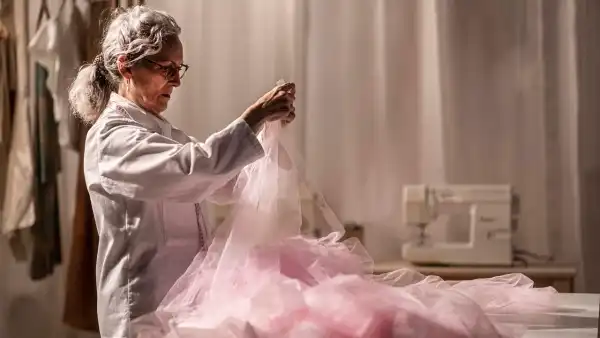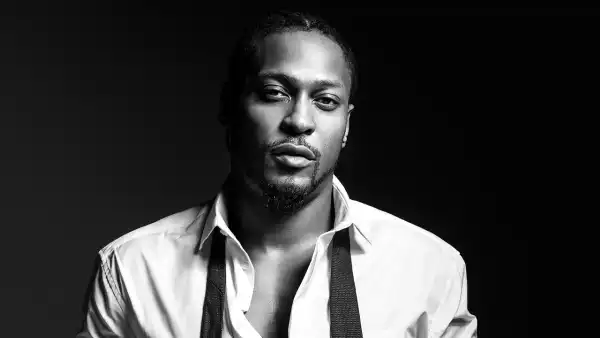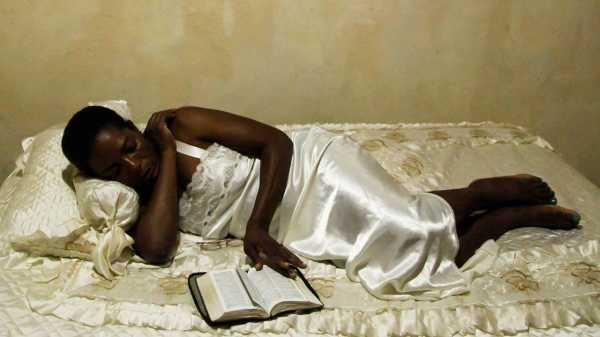
Save this storySave this storySave this storySave this story
“When the psychohistory of a people is marked by ongoing loss, when entire histories are denied, hidden, erased, documentation can become an obsession,” bell hooks writes in her book “Art on My Mind: Visual Politics,” from 1995. She describes photography, in particular, as an accessible medium through which Black Americans, who had been shut out of white art institutions for most of the twentieth century, could picture themselves as they wished to be seen, and create “private, black-owned and -operated gallery space[s]” within their own homes.
I thought of hooks’s work when viewing “Rest Is Power,” an exhibition at N.Y.U. that gathers more than thirty artists from across the Black diaspora, most of them photographers (standard-bearers like Gordon Parks and Carrie Mae Weems, and younger practitioners like Tyler Mitchell and Daveed Baptiste) to craft a more public, but no less intimate or restorative, counternarrative about Black life. The exhibition, on view at 20 Cooper Square through October 22nd, features Black people in various states of repose (as well as unpopulated interiors and landscapes), from New York to Pujehun, Sierra Leone. The show is part of a broader initiative called the Black Rest Project, through which partner organizations including the Maroon Arts Group, in Columbus, Ohio, and Commissioner, in Miami, will explore the complexities of rest for Black people, and challenge the binary assumption that one can either slow down or make a living, can either struggle or sleep (a myth encoded in the activist mandate to “stay woke”).
The curators Joan Morgan, Deborah Willis, and Kira Joy Williams (Willis and Williams are also photographers) conceived of the exhibition this spring, Morgan says, to address the collective exhaustion they perceived, “which was odd, after a three-year period when we were supposed to be sitting still.” An awareness that stillness was denied to Black and brown frontline workers heightened the guilt and anxiety about resting for those who could afford to do so. Yet “Rest Is Power” suggests an affective continuity between Black labor within and beyond the academy. The exhibit’s catalogue essay traces the marriage of work and worth back to slavery, when “the Black body’s value in the ‘new’ world was originally assigned, not by the lens of mutual humanity, but solely by its capacity for physical, emotional and sexual labor.”
The politicization of rest is rooted in earlier Black feminist writings: Alice Walker’s novel “Meridian” (1976) and Toni Cade Bambara’s “The Salt Eaters” (1980) both document the physical and psychic danger of fatigue for Black women activists. Both works anticipate Audre Lorde’s and hooks’s calls for Black self-care—which Lorde, in her 1988 book “A Burst of Light,” describes as “an act of political warfare.” The pandemic, along with the latest wave of movement activism, has revived interest in rest. In 2022, the theologian Tricia Hersey published “Rest Is Resistance,” a best-selling manifesto that calls all people, but especially Black people, to slow down, not as a means toward future productivity but as an act of defiance. Earlier this year, Sosa and Navild Acosta’s participatory installation, “Black Power Naps,” which was first presented in 2018 and had its New York début in 2019, at Performance Space, was staged (with a bit more strain) at the predominantly white space of MOMA. The curators invited guests to sleep and lounge as a means of “refus[ing] institutionalized exhaustion” and “redistribut[ing] idleness, down time, and quality sleep.”
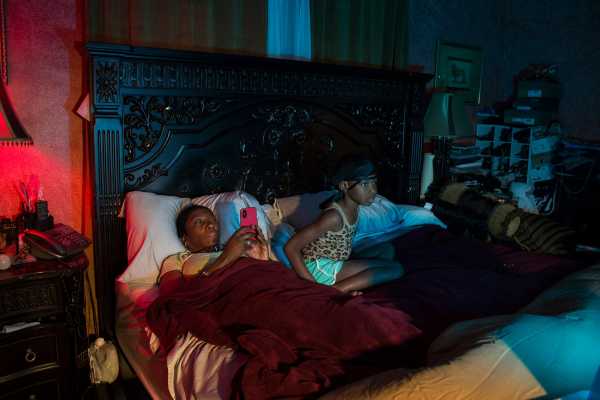
“Mass Media,” 2020.Photograph by Cornelius Tulloch
The exhibition at 20 Cooper Square, though indebted to Hersey’s ideas, is unique in making rest not only a cultural directive but an aesthetic question—a matter of what hooks called visual politics. On the most basic level, Black people are generally pictured as doing anything but relaxing—as being attacked, or agitating, or performing feats of athleticism or entertainment. It can seem that Black ease is permitted only in death, as in the benediction to which the exhibition title alludes, “Rest in power.” Yet rest seems elusive in life, the curators suggest, in part because it is rarely represented in art. Their images testify to the fact that everyday people have long rested on stoops and at corners, at family picnics and in prayer. The pictures coalesce into a vision of Black life that does not proceed from crisis to achievement to crisis but from one moment of leisure to the next.
Some works consciously intervene into a tradition in which white rest is predicated on Black labor. The fourth panel of Weems’s 1997 black-and-white self-portrait “Not Manet’s Type” (reprinted in 2010) recalls a history of European painting in which Black people are included only as attendants to white leisure—as in Manet’s notorious “Olympia” (1863), in which a Black woman delivers an armful of pale flowers to a nude white woman who seems to ignore her, gazing out at the viewer instead. In her self-portrait, Weems sits on her bed in a dark negligee, her image focalized through the round mirror on her dressing table. In Jamel Shabazz’s less oppositional but no less posed Brooklyn street portrait “The Young” (circa 1986), a stylish woman drapes her arm around a man who holds their newborn daughter and beams at the camera. Here, as in so many of the works on view, the artist approaches the subjects with obvious affection, which is rewarded by trust. (Shabazz, now sixty-three, tells me he had known the man, Robert Dupreme Eatman, for years prior to taking the picture; they remain close friends.)
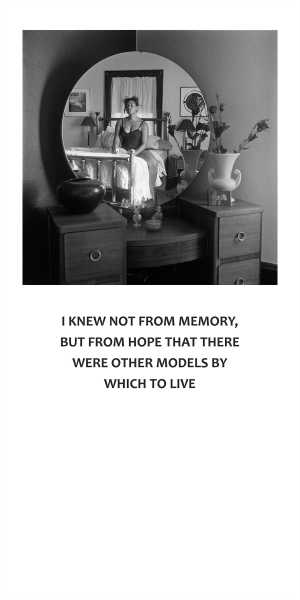
“Not Manet's Type,” Panel 4, 2010.Photograph © Carrie Mae Weems / Courtesy Jack Shainman Gallery
In some images, repose is decadent: Renee Cox’s “Miss Thang” (2009) lounges in a hot tub, smoking, a bottle of rum and a snifter by her side. There are also milder affects: in Jamaica Gilmer’s black-and-white portrait “Amber Santibanez” (2021), a woman sits on a bench nursing an infant, so small that the child still hews to the mother in a single line, chubby legs stuck straight out; the mother wears angular sunglasses and a white tank top that reads “Free Spirit.” When selecting the images, the curators asked themselves what qualified as rest, and what would translate to viewers as such. These are cultural, and to some extent generational, questions. Those familiar with stoop culture are more likely to appreciate how restful it is to spend time there; in Danielle (Dae) Tyas’s “Days Before Tori” (2021), a man and a pregnant woman embrace, seated on a step while a toddler plays in front of them. Patrons of beauty shops and barbershops (depicted in Jeffrey Henson Scales’s 1987 photo “House’s Barber Shop” and Willis’s own “Mrs. Brown’s Beauty Shop, Philadelphia (shampoo),” from 1999) will see them as spaces of respite. They might also apprehend what Willis calls the occasionally “horrific” social context that makes these spaces precious.
Perhaps the portrayal of Black idleness will always be, if not haunted, then framed by a broader context that makes it seem like an act of resistance rather than a simple fact of life. “When we talk about Black people and time,” Morgan says, “we’re talking about stolen labor, stolen time—and each of these images steals it back.” The images also invite viewers to steal back personal memory—to reframe moments when they were resting, even if they didn’t know it. This might account for the sense of nostalgia that pervades the gallery (in some works, intentionally: Colette Veasey-Cullors explained to me that she muted the colors on her image of her late grandmother’s bed—in “her bed,” from 2013—to allow more “space for memory recall”). But the nostalgia is productive. The curators both conserve and create a genealogy of global Black life in which the works speak to one another, as much as they speak back to the white institution in which they are housed, or to a history of Black unrest. They show that Black people around the world have been reposing, alone and in each other’s arms, for a long time. “This actually happens,” Williams says: “We can actually rest.” The acknowledgment nudges Hersey’s didactic, paradoxically galvanizing call to rest toward a simpler message: More of this. ♦
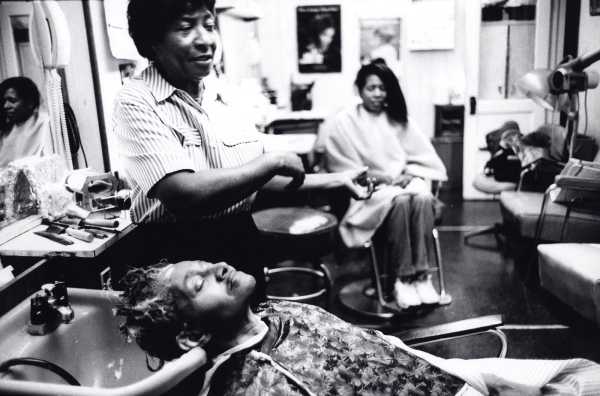
“Mrs. Brown’s Beauty Shop, Philadelphia (shampoo),” 1999.Photograph by Dr. Deborah Willis
Sourse: newyorker.com



